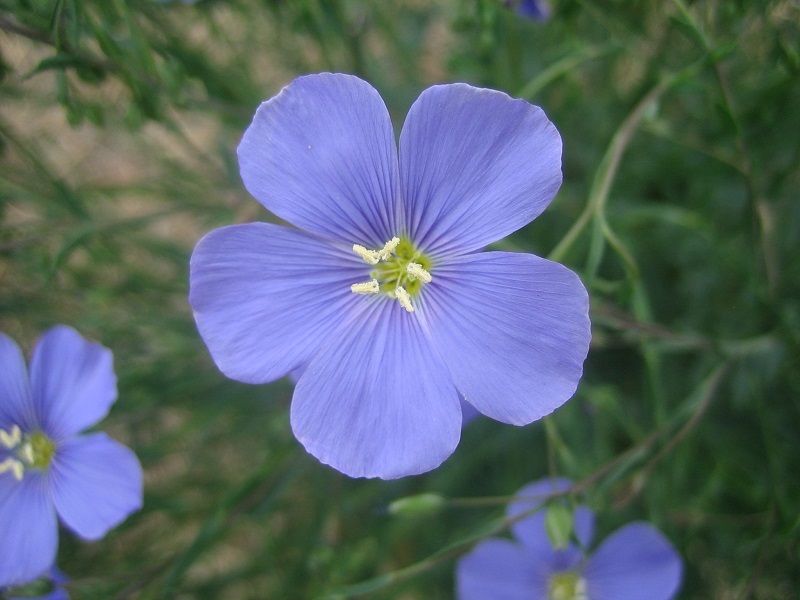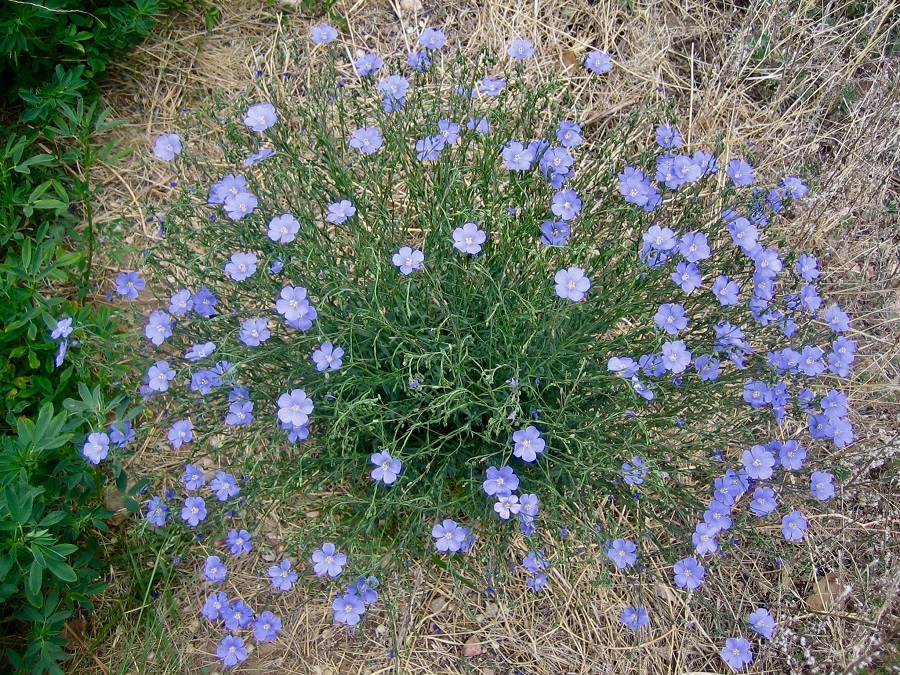Scientific name: Linum lewisii and Linum perenne
Common name: blue flax
Plant family: Linaceae (flax)
Article by Peggy Rudberg
“Primary Blue”

Photo by Peggy Rudberg
What could be more delightful than a field of cheerful swaying flowers matching a clear blue summer sky? These charming floral displays occur naturally in open meadows and woodlands from Alaska to Mexico, from sea level in the flower’s northern range to 10,000 feet in its southern range. The dazzling blue flower is commonly called blue flax. One of the most common of over 200 species worldwide is the American herbaceous perennial Linum lewisii. The Santa Fe Botanical Garden displays Linum perenne, a common garden variety originating in Eurasia almost identical to our native species. Both are profiled here as only a slight difference in the length of the five styles (female reproductive parts located in the flower center) in relationship to the length of the five stamens (male pollen producers surrounding the styles) distinguishes the two. (The styles of L. lewisii are all the same length.) L. perenne has escaped from gardens and naturalized across North America producing cultivars like Linum perenne ‘Appar’, found in North Dakota in 1955. Due to its tolerance for poor soil and prolific early blooming, ‘Appar’ is often used in restorative roadside or wildflower mixes. DNA testing has shown that the perenne species are reproductively isolated from our native species, in other words genetic barriers prevent interbreeding, presenting no threat to our native flax. All three of these species are available in the garden trade.
L. lewisii was one of 178 new plants collected by Meriwether Lewis on his expedition to the Pacific Northwest in 1805. Blooming from late spring through fall the five ray petals of the single blossoms range from deep to pale blue with dark veins radiating from a yellow center. A single slender stem sheathed in narrow alternate leaves bears one-inch wedge shaped flowers that bloom sequentially one at a time starting from the bottom upward. The weight of the higher buds waiting to blossom often causes the thin stems to nod, creating an arching silhouette. The blooms are early risers but fade in the heat of the afternoon, each one lasting only one day. After blooming, a small round fruit capsule is produced that splits when mature, releasing 10 or more seeds each while the next flowers open in succession above. Blue flax propagates from its dispersed seeds.

Blue flax growing along the Santa Fe river. Photo by Peggy Rudberg.
Often found in scrubland and sagebrush communities as well as piñon-juniper woodlands, blue flax favors a sunny location, but can also grow successfully in partial shade. It is not fussy about soil and does well in barren earth that is sandy, calcareous or alkaline. A hot dry habitat with good drainage is preferred for these drought tolerant species but in your garden, supplemental watering can produce taller more vigorous plants. Pollinators are bees attracted by the nectar, flies that feast on the pollen and the grazing larvae of some Lepidoptera species. Birds and mice feed on the seeds.
The genus Linum belongs to the venerable plant family Linaceae, which also contains Linum usitatissumum, the source both ancient and modern, of oil, seeds and fibers. L. usitatissimum is an annual native to the Middle East and humans have used its seeds and tough fibrous stems since Neolithic times. Egyptian mummies were wrapped in cloth made of flax. Vegetable oil has been extracted from the seeds for centuries and seeds themselves have been found in the digestive tract of bog bodies 2400 years old. Flax seeds are high in omega-3s, dietary fiber and other essential nutrients and are popular today as a health food.
The scientific genus name Linum was created by Linnaeus from Latin for “flax”, but lin, line, lein and many other similar terms are most likely pre Latin and derived from Proto-Indo-European words for the flax based lines, threads and nets used by our ancestors. Usitatissimum is Latin for “most useful”, perenne means “perennial” and lewisii is of course named for Meriwether Lewis.
Keep blue flax in mind when seeking a care free and cheery addition to a xeric or pollinator flower patch.
References
Vaisey-Genser, Marion and Morris, Diane H. “Flax”. Taylor & Francis Group. 2003. Web. 1 May 2023. Retrieved from: https://www.taylorfrancis.com/chapters/edit/10.1201/9780203437506-5/introduction-history-cultivation-uses-flaxseed-marion-vaisey-genser-diane-morris?context=ubx
“Blue flax Lewis flax”. USDA-NRCS. 2001. Web. 1 May 2023. Retrieved from:
https://plants.usda.gov › DocumentLibrary › plantguide › pdf › pg_lile3.pdf
“Linum Usitatissmum”. ScienceDirect. 2023. Web. 1 May 2023. Retrieved from:
https://www.sciencedirect.com/topics/agricultural-and-biological-sciences/linum-usitatissimum


